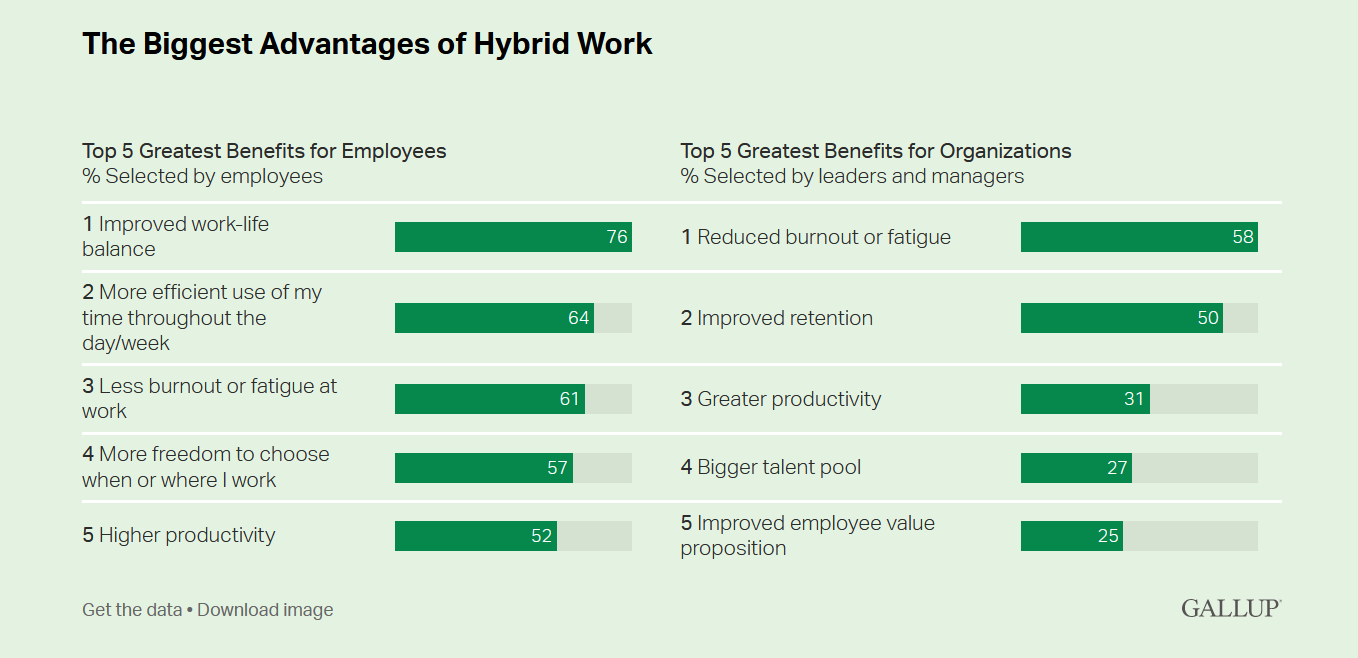Recent Research about Remote and Hybrid Employees
Employees are returning to the office, but with more remote work flexibility than ever before. While it’s clear that remote and hybrid work is here to stay, it can be hard to navigate the continually evolving territory while also ensuring employees stay connected and feel appreciated. We wanted to highlight recent research about remote and hybrid workers and company hybrid policy from Gallup and McKinsey & Company that address some of the successes and challenges of these new work arrangements.
Gallup – The Good and Bad of Hybrid Work
In August, Gallup released the podcast The Great ‘Global Work-from-Home Experiment’ and Its Results and then followed it up in October with the article The Future of the Office Has Arrived: It’s Hybrid. We have summarized some of the highlights below, but you can read the full article and listen to the entire podcast by clicking the links in the titles.
The results of Gallup’s surveys were similar to those from the poll we conducted earlier in the year about what remote workers like and dislike about working from home. Covid not only changed how we work, but also how we expect to work from now on. Of workers who have remote-capable jobs, 80-90% expect to be able to work remotely at least some of the time. And if we aren’t going back to the way things were, we need to rethink the best practices for going forward.
Gallup data indicates 2-3 days in the office is both most desired by employees at all levels and most optimal for engagement. For remote-capable employees who are currently working where they expect to work long-term, the good news is that today’s close alignment between employees’ preferred and actual work locations tends to create a better employee experience. When employees work from their desired location, they tend to be more engaged at work, less likely to burn out and less likely to quit. Gallup laid out the other top benefits of hybrid work for both employees and companies in this table.
Gallup also laid out some of the challenges that the new hybrid work environment has created. Many of which are related to connectedness and communication.
Leaning Into Advantages and Overcoming Challenges
It’s important to note that these challenges are reported by employees at only half the rate of the advantages. Meaning, 52-76% of employees reported positive benefits with only 18% to 31% of the hybrid workforce reporting the top challenges. This suggests that the benefits of hybrid work can significantly outweigh the risks when managed successfully.
The most important take-aways from Gallup’s research on hybrid work teams are:
- Each organization and team needs to be flexible about its hybrid arrangements, assess regularly and make sure they are including feedback from their employees.
- Each organization needs to be clear about its philosophy and policy about hybrid work, while also allowing individual teams to adapt that policy to their needs and making sure workers have a clear idea what is expected of them.
- Managers need training to be able to successfully lead hybrid teams. 80% of hybrid workers have not received any formal training on how to best work in a hybrid environment and 73% of hybrid managers and senior leaders are equally unprepared to lead hybrid teams. Yet, Gallup finds that having an effective manager is four times more important to team members’ engagement and wellbeing than where an employee works.
McKinsey & Company’s McKinsey Quarterly: Disengaged Employees
The September issue of McKinsey Quarterly included the article, Some employees are destroying value. Others are building it. Do you know the difference? where they published their research on disengaged employees.
As hybrid work arrangements continue to evolve, companies want to know how to minimize the damage of the dissatisfied and disengaged and maximize (and keep happy) the work of their best and brightest employees. Especially when, according to the new research, employee disengagement and attrition can cost a median-size company between $228-$355 million a year in lost productivity. McKinsey writes that the first step is for leadership to recognize that remote workers are not all the same. So, tactics and strategies to increase performance and levels of well-being and commitment need to be tailored. Their research broke workers down into six types: the quitters, the disruptors, the mildly disengaged, the double-dippers, the reliable and committed, the thriving stars. The main challenge for organizations is to move as many workers as possible from being highly dissatisfied toward greater engagement and commitment.
Some of the important take-aways:
- The higher the level of satisfaction experienced by employees, the higher their performance and well-being. The opposite is true as well.
- Leaders who are connected to their teams can keep a pulse on morale, helping to make people feel valued.
- When employees are dissatisfied and seeking recognition for their value, compensation acts as only a temporary motivator for retention. People are motivated by meaningful work, flexibility, and a workplace environment that has supportive coworkers.
- Like Gallup, McKinsey found that managers with hybrid teams need more training, finding that only 15% of manager are comfortable managing remote and hybrid teams.
Conclusion
Employees have new expectations for where and how they will work. And employers have largely embraced the advantages of remote and hybrid work and the opportunity to provide their people with flexibility. But what leaders need now is a long-term hybrid strategy that will work best for their organization into the future and support their individual workplace culture.
Research suggests the most successful organizations will have hybrid policies that are both clear and flexible and ensure their managers and teams get necessary training on how best to work in hybrid environments. In the post-Covid work environment, getting remote work right is better for businesses and better for employees, too.
Tags: remote management, remote staffCategories 5 Languages of Appreciation, Appreciation, Business/Leadership, Managers, Remote Employees, Virtual teams, Workplace Culture




